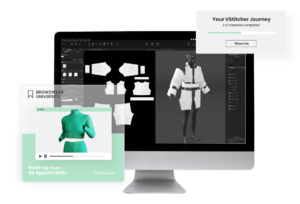Every day, we are surrounded by different kinds of colorful and bright textiles, but have you ever thought of how the patterns on the textiles are designed?
Let’s start from the beginning:
What is CAD?
 Computer-aided design (CAD) is a software tool that gives apparel designers a virtual representation of the garments they are designing. CAD software enables textile designers to utilize their creativity to the fullest when designing knits, printed and woven patterns. By textile designers implementing CAD into their apparel design workflow allows textile designers to virtually experiment and make any changes and alterations to the garment before taking it to production.
Computer-aided design (CAD) is a software tool that gives apparel designers a virtual representation of the garments they are designing. CAD software enables textile designers to utilize their creativity to the fullest when designing knits, printed and woven patterns. By textile designers implementing CAD into their apparel design workflow allows textile designers to virtually experiment and make any changes and alterations to the garment before taking it to production.
CAD can be used to design curves and figures in 2D and can be subsequently converted to 3D CAD for a better representation, as well as virtually prototype 2D designs through Browzwear’s 3D clothing design software, VStitcher . By utilizing VStitcher, textile designers can design fabric while simultaneously having the capability to visualize the finished garment in real time, giving the designer more room to control and minimize any errors.
How is 3D CAD used in the textile design industry?
 VStitcher is the latest innovation to the textile designer’s toolkit. The 3D clothing design software gives designers the capacity to visualize completed garments virtually, which has streamlined and accelerated product development from concept all the way to creation. With VStitcher, there is less of a need for iterations of physical prototypes as designers can make all changes and alterations virtually to refine the product. This results in higher quality garments with lower pre-production costs and faster time to market.
VStitcher is the latest innovation to the textile designer’s toolkit. The 3D clothing design software gives designers the capacity to visualize completed garments virtually, which has streamlined and accelerated product development from concept all the way to creation. With VStitcher, there is less of a need for iterations of physical prototypes as designers can make all changes and alterations virtually to refine the product. This results in higher quality garments with lower pre-production costs and faster time to market.
What is the end-to-end design process utilizing 3D CAD?
3D Sampling
By removing physical samples from the equation, textile designers can digitally draft, edit, and validate styles without sewing a single seam. From a 2D sketch adapted to a 3D garment, the designer can now create patterns and styles directly on the digital garment with the ability to make any alterations and showcase different variations before going to production.
By creating samples utilizing 3D CAD software, apparel organizations can shorten the product development time and make decisions from anywhere around the world while, at the same time, reducing unnecessary waste.
Fit Evaluation
3D CAD enables designers to implement the fit evaluation process in real-time during the early stages on a digital avatar that can be adjusted according to human body measurements, body types, shapes, and sizes. Through this process, designers can now get a true-to-life visual of how the digital garment fits, folds, and drapes, without waiting months to see a physical sample.
With Browzwear’s collaboration platform Stylezone , designers can communicate, review and approve from wherever they may be in the world.
Visualization
With 3D CAD visualization capabilities, apparel designers can leverage a variety of features and functions to get the most accurate idea of the garment’s final outcome.
By having the ability to analyze every detail of the garment, down to the fabric composition and quality of the garment, 3D visualization helps to improve the manufacturing process by making sure that there is there is complete transparency regarding the requirements and intricate details that make up the garment.
Showcasing
Through many different interactive platforms, specifically Stylezone, textile designers can now easily collaborate and validate garments in 3D CAD to design efficiently with the input of all relevant stakeholders worldwide and get them involved in the process before any samples are produced.
Stylezone enables designers to showcase digital samples for immediate feedback, accelerating the decision-making process as stakeholders can now collaborate in making edits and adjustments to the garment, reducing time to market.
Manufacturing
Throughout the manufacturing phase of the digital design cycle, there is no unnecessary pressure on manufacturers to produce physical samples. The production of the 3D garment is error-proof as all changes have already been made, resulting in minimal fabric waste. If there are any unsold samples, they can be altered and repurposed for future collections. Therefore, the 3D CAD design process allows for a more streamlined and efficient end-to-end workflow, resulting in an accurate pre-production process.
If you’re ready to explore the world of 3D fashion design and achieve your creative potential, schedule a demo to see Browzwear’s 3D fashion design software in action.